Public Bike Trip Purpose Inference Using Point-of-Interest Data
Abstract
:1. Introduction
2. Related Works
2.1. Studies on Trip Purpose Inference
2.2. Studies Related to POI Embedding
3. Methods
3.1. Feature Extraction for Inference of Trip Purpose
3.2. Identification of Land Use in Bike Trips
3.2.1. POI Type Embedding Related to Bike Trip Purpose
3.2.2. Extracting the Land Use at Each Station
3.3. Creation of Ground Truth Data Related to Trip Purpose
3.3.1. Standardization of Mesh Data
3.3.2. Extraction of Bike Trip Purpose
3.4. Training for Machine Learning
4. Experiments and Results
4.1. Data
4.2. Extracted Land Use at Bike Stations by POI Type Embedding
4.3. Results of Public Bike Trip Purpose Inference
5. Discussion and Conclusions
Author Contributions
Funding
Informed Consent Statement
Data Availability Statement
Conflicts of Interest
References
- Bao, J.; Xu, C.; Liu, P.; Wang, W. Exploring Bikesharing Travel Patterns and Trip Purposes Using Smart Card Data and Online Point of Interests. Netw. Spat. Econ. 2017, 17, 1231–1253. [Google Scholar] [CrossRef]
- Xing, Y.; Wang, K.; Lu, J.J. Exploring travel patterns and trip purposes of dockless bike-sharing by analyzing massive bike-sharing data in Shanghai, China. J. Transp. Geogr. 2020, 87, 102787. [Google Scholar] [CrossRef]
- Yang, Y.; Heppenstall, A.; Turner, A.; Comber, A. A spatiotemporal and graph-based analysis of dockless bike sharing patterns to understand urban flows over the last mile. Comput. Environ. Urban. Syst. 2019, 77, 101361. [Google Scholar] [CrossRef]
- Fishman, E. Bikeshare: A Review of Recent Literature. Transp. Rev. 2016, 36, 92–113. [Google Scholar] [CrossRef]
- Saberi, M.; Ghamami, M.; Gu, Y.; Shojaei, M.H.; Fishman, E. Understanding the impacts of a public transit disruption on bicycle sharing mobility patterns: A case of Tube strike in London. J. Transp. Geogr. 2018, 66, 154–166. [Google Scholar] [CrossRef]
- Guirao, B.; Ampudia, M.; Molina, R.; García-Valdecasas, J. Student behaviour towards Free-Floating Carsharing: First evidences of the experience in Madrid. Transp. Res. Procedia 2018, 33, 243–250. [Google Scholar] [CrossRef]
- Le Vine, S.; Polak, J. The impact of free-floating carsharing on car ownership: Early-stage findings from London. Transp. Policy 2019, 75, 119–127. [Google Scholar] [CrossRef]
- Xu, Y.; Chen, D.; Zhang, X.; Tu, W.; Chen, Y.; Shen, Y.; Ratti, C. Unravel the landscape and pulses of cycling activities from a dockless bike-sharing system. Comput. Environ. Urban. Syst. 2019, 75, 184–203. [Google Scholar] [CrossRef]
- Ai, Y.; Li, Z.; Gan, M.; Zhang, Y.; Yu, D.; Chen, W.; Ju, Y. A deep learning approach on short-term spatiotemporal distribution forecasting of dockless bike-sharing system. Neural Comput. Appl. 2018, 31, 1665–1677. [Google Scholar] [CrossRef]
- Zhao, J.; Fan, W.; Zhai, X. Identification of land-use characteristics using bicycle sharing data: A deep learning approach. J. Transp. Geogr. 2020, 82, 102562. [Google Scholar] [CrossRef]
- Osama, A.; Sayed, T.; Bigazzi, A.Y. Models for estimating zone-level bike kilometers traveled using bike network, land use, and road facility variables. Transp. Res. Part A Policy Pr. 2017, 96, 14–28. [Google Scholar] [CrossRef]
- Yang, Y.; Heppenstall, A.; Turner, A.; Comber, A. Who, Where, Why and When? Using Smart Card and Social Media Data to Understand Urban Mobility. ISPRS Int. J. Geo-Inform. 2019, 8, 271. [Google Scholar] [CrossRef] [Green Version]
- Cui, Y.; Meng, C.; He, Q.; Gao, J. Forecasting current and next trip purpose with social media data and Google Places. Transp. Res. Part C Emerg. Technol. 2018, 97, 159–174. [Google Scholar] [CrossRef]
- Ermagun, A.; Fan, Y.; Wolfson, J.; Adomavicius, G.; Das, K. Real-time trip purpose prediction using online location-based search and discovery services. Transp. Res. Part C Emerg. Technol. 2017, 77, 96–112. [Google Scholar] [CrossRef]
- Gong, L.; Morikawa, T.; Yamamoto, T.; Sato, H. Deriving Personal Trip Data from GPS Data: A Literature Review on the Existing Methodologies. Procedia Soc. Behav. Sci. 2014, 138, 557–565. [Google Scholar] [CrossRef] [Green Version]
- Montini, L.; Rieser-Schüssler, N.; Horni, A.; Axhausen, K.W. Trip Purpose Identification from GPS Tracks. Transp. Res. Rec. J. Transp. Res. Board 2014, 2405, 16–23. [Google Scholar] [CrossRef]
- Nguyen, M.H.; Armoogum, J.; Madre, J.-L.; Garcia, C. Reviewing trip purpose imputation in GPS-based travel surveys. J. Traffic Transp. Eng. 2020, 7, 395–412. [Google Scholar] [CrossRef]
- Alsger, A.; Tavassoli, A.; Mesbah, M.; Ferreira, L.; Hickman, M. Public transport trip purpose inference using smart card fare data. Transp. Res. Part C Emerg. Technol. 2018, 87, 123–137. [Google Scholar] [CrossRef]
- Bohte, W.; Maat, K. Deriving and validating trip purposes and travel modes for multi-day GPS-based travel surveys: A large-scale application in the Netherlands. Transp. Res. Part C Emerg. Technol. 2009, 17, 285–297. [Google Scholar] [CrossRef]
- Deng, Z.; Ji, M. Deriving Rules for Trip Purpose Identification from GPS Travel Survey Data and Land Use Data: A Machine Learning Approach. In Proceedings of the Seventh International Conference on Traffic and Transportation Studies (ICTTS) 2010, Kunming, China, 3–5 August 2010. [Google Scholar]
- Zhang, X.; Sun, Y.; Zheng, A.; Wang, Y. A New Approach to Refining Land Use Types: Predicting Point-of-Interest Categories Using Weibo Check-in Data. ISPRS Int. J. Geo-Inform. 2020, 9, 124. [Google Scholar] [CrossRef] [Green Version]
- Long, Y.; Liu, X. Featured Graphic. How Mixed is Beijing, China? A Visual Exploration of Mixed Land Use. Environ. Plan. A Econ. Space 2013, 45, 2797–2798. [Google Scholar] [CrossRef]
- Liu, K.; Yin, L.; Lu, F.; Mou, N. Visualizing and exploring POI configurations of urban regions on POI-type semantic space. Cities 2020, 99, 102610. [Google Scholar] [CrossRef]
- Yan, B.; Janowicz, K.; Mai, G.; Gao, S. From itdl to place2vec: Reasoning about place type similarity and relatedness by learning embeddings from augmented spatial contexts. In Proceedings of the 25th ACM SIGSPATIAL International Conference on Advances in Geographic Information Systems, Redondo Beach, CA, USA, 7–10 November 2017. [Google Scholar]
- Zhai, W.; Bai, X.; Shi, Y.; Han, Y.; Peng, Z.-R.; Gu, C. Beyond Word2vec: An approach for urban functional region extraction and identification by combining Place2vec and POIs. Comput. Environ. Urban. Syst. 2019, 74, 1–12. [Google Scholar] [CrossRef]
- Feng, S.; Cong, G.; An, B.; Chee, Y.M. Poi2vec: Geographical latent representation for predicting future visitors. In Proceedings of the Thirty-First AAAI Conference on Artificial Intelligence, San Francisco, CA, USA, 4–9 February 2017. [Google Scholar]
- Yao, Y.; Li, X.; Liu, X.; Liu, P.; Liang, Z.; Zhang, J.; Mai, K. Sensing spatial distribution of urban land use by integrating points-of-interest and Google Word2Vec model. Int. J. Geogr. Inf. Sci. 2017, 31, 825–848. [Google Scholar] [CrossRef]
- Chen, C.; Jiao, S.; Zhang, S.; Liu, W.; Feng, L.; Wang, Y. TripImputor: Real-Time Imputing Taxi Trip Purpose Leveraging Multi-Sourced Urban Data. IEEE Trans. Intell. Transp. Syst. 2018, 19, 3292–3304. [Google Scholar] [CrossRef]
- Meng, C.; Cui, Y.; He, Q.; Su, L.; Gao, J. Travel purpose inference with GPS trajectories, POIs, and geo-tagged social media data. In Proceedings of the 2017 IEEE International Conference on Big Data, Boston, MA, USA, 11–14 December 2017. [Google Scholar]
- Zhang, Z.; He, Q.; Zhu, S. Potentials of using social media to infer the longitudinal travel behavior: A sequential model-based clustering method. Transp. Res. Part C Emerg. Technol. 2017, 85, 396–414. [Google Scholar] [CrossRef]
- Buck, D.; Buehler, R.; Happ, P.; Rawls, B.; Chung, P.; Borecki, N. Are bikeshare users different from regular cyclists? A first look at short-term users, annual members, and area cyclists in the Washington, DC, region. Transp. Res. Record 2013, 2387, 112–119. [Google Scholar] [CrossRef]
- Fishman, E.; Washington, S.; Haworth, N.; Watson, A. Factors influencing bike share membership: An analysis of Melbourne and Brisbane. Transp. Res. Part A Policy Pract. 2015, 71, 17–30. [Google Scholar] [CrossRef] [Green Version]
- Campbell, A.A.; Cherry, C.R.; Ryerson, M.S.; Yang, X. Factors influencing the choice of shared bicycles and shared electric bikes in Beijing. Transp. Res. Part C Emerg. Technol. 2016, 67, 399–414. [Google Scholar] [CrossRef] [Green Version]
- Chen, C.; Liao, C.; Xie, X.; Wang, Y.; Zhao, J. Trip2Vec: A deep embedding approach for clustering and profiling taxi trip purposes. Pers. Ubiquitous Comput. 2018, 23, 53–66. [Google Scholar] [CrossRef]
- Gao, S.; Yan, B. Place2Vec: Visualizing and Reasoning About Place Type Similarity and Relatedness by Learning Context Embeddings. In Proceedings of the Adjunct Proceedings of the 14th International Conference on Location Based Services, Zurich, Switzerland, 15–17 January 2018. [Google Scholar]
- Liu, K.; Gao, S.; Qiu, P.; Liu, X.; Yan, B.; Lu, F. Road2Vec: Measuring Traffic Interactions in Urban Road System from Massive Travel Routes. ISPRS Int. J. Geo-Inform. 2017, 6, 321. [Google Scholar] [CrossRef] [Green Version]
- Crivellari, A.; Beinat, E. From Motion Activity to Geo-Embeddings: Generating and Exploring Vector Representations of Locations, Traces and Visitors through Large-Scale Mobility Data. ISPRS Int. J. Geo-Inform. 2019, 8, 134. [Google Scholar] [CrossRef] [Green Version]
- Liu, X.; Andris, C.; Rahimi, S. Place niche and its regional variability: Measuring spatial context patterns for points of interest with representation learning. Comput. Environ. Urban. Syst. 2019, 75, 146–160. [Google Scholar] [CrossRef]
- Jin, J.; Xiao, Z.; Qiu, Q.; Fang, J. A Geohash Based Place2vec Model. In Proceedings of the IGARSS 2019—2019 IEEE International Geoscience and Remote Sensing Symposium, Yokohama, Japan, 28 July–2 August 2019. [Google Scholar]
- Faghih-Imani, A.; Eluru, N. Incorporating the impact of spatio-temporal interactions on bicycle sharing system demand: A case study of New York CitiBike system. J. Transp. Geogr. 2016, 54, 218–227. [Google Scholar] [CrossRef]
- Pewresearch. Available online: https://www.pewresearch.org/global/2019/02/05/smartphone-ownership-is-growing-rapidly-around-the-world-but-not-always-equally (accessed on 15 April 2021).
- KOSTAT. Available online: http://sgis.kostat.go.kr (accessed on 15 April 2021).
- Wu, J.; Jiang, C.; Houston, D.; Baker, D.; Delfino, R. Automated time activity classification based on global positioning system (GPS) tracking data. Environ. Health 2011, 10, 101. [Google Scholar] [CrossRef] [PubMed] [Green Version]
- Lu, Y.; Liu, Y. Pervasive location acquisition technologies: Opportunities and challenges for geospatial studies. Comput. Environ. Urban. Syst. 2012, 36, 105–108. [Google Scholar] [CrossRef]
- Kim, Y.; Pereira, F.C.; Zhao, F.; Ghorpade, A.; Zegras, P.C.; Ben-Akiva, M. Activity recognition for a smartphone and web based travel survey. arXiv 2015, arXiv:1502.03634 2015. [Google Scholar]
- Oliveira, M.G.S.; Vovsha, P.; Wolf, J.; Mitchell, M. Evaluation of Two Methods for Identifying Trip Purpose in GPS-Based Household Travel Surveys. Transp. Res. Rec. J. Transp. Res. Board 2014, 2405, 33–41. [Google Scholar] [CrossRef]
- Diaz-Uriarte, R.; De Andrés, S.A. Gene selection and classification of microarray data using random forest. BMC Bioinform. 2006, 7, 3. [Google Scholar] [CrossRef] [Green Version]
- Gong, L.; Liu, X.; Wu, L.; Liu, Y. Inferring trip purposes and uncovering travel patterns from taxi trajectory data. Cartogr. Geogr. Inf. Sci. 2016, 43, 103–114. [Google Scholar] [CrossRef]
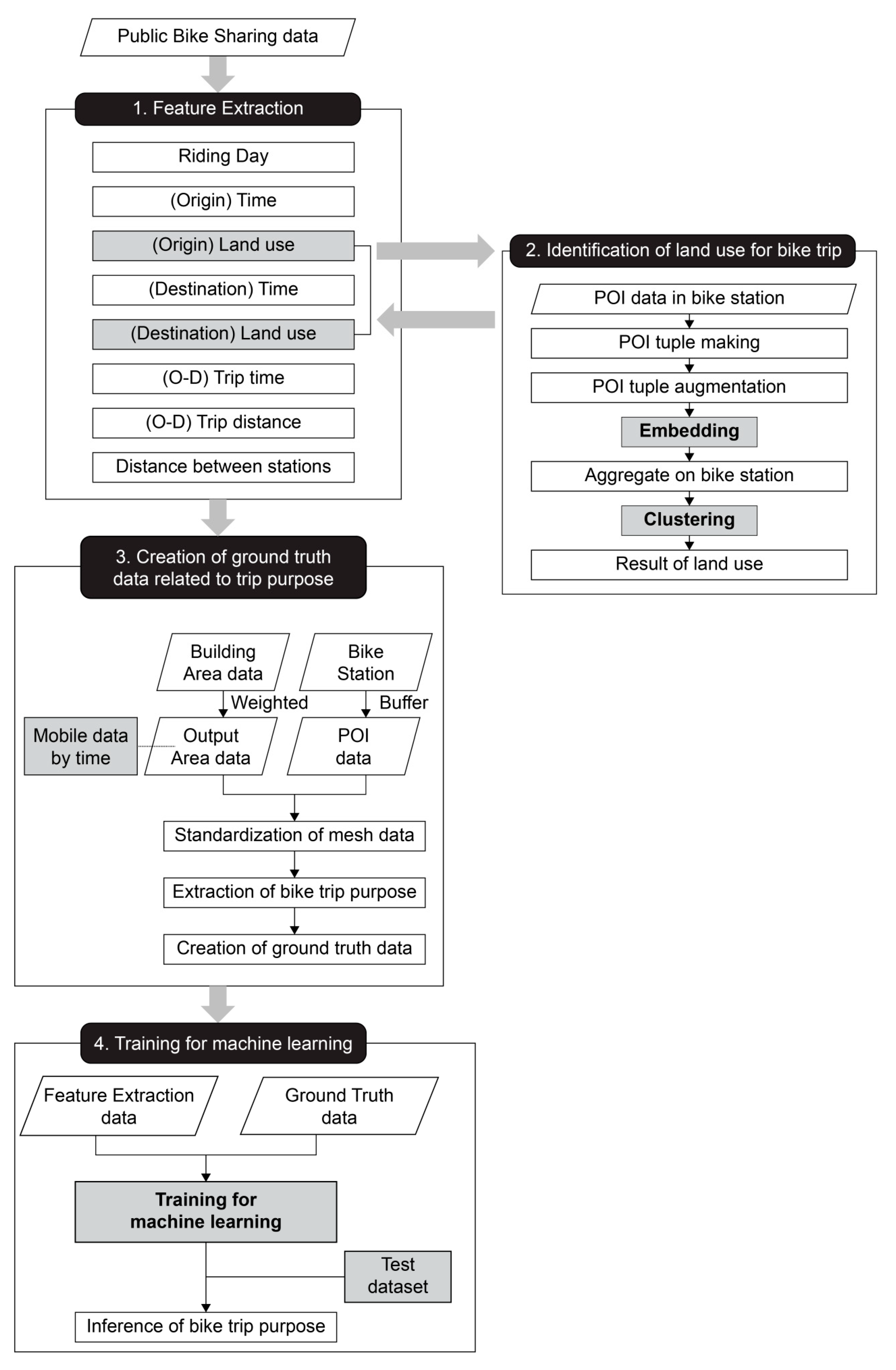
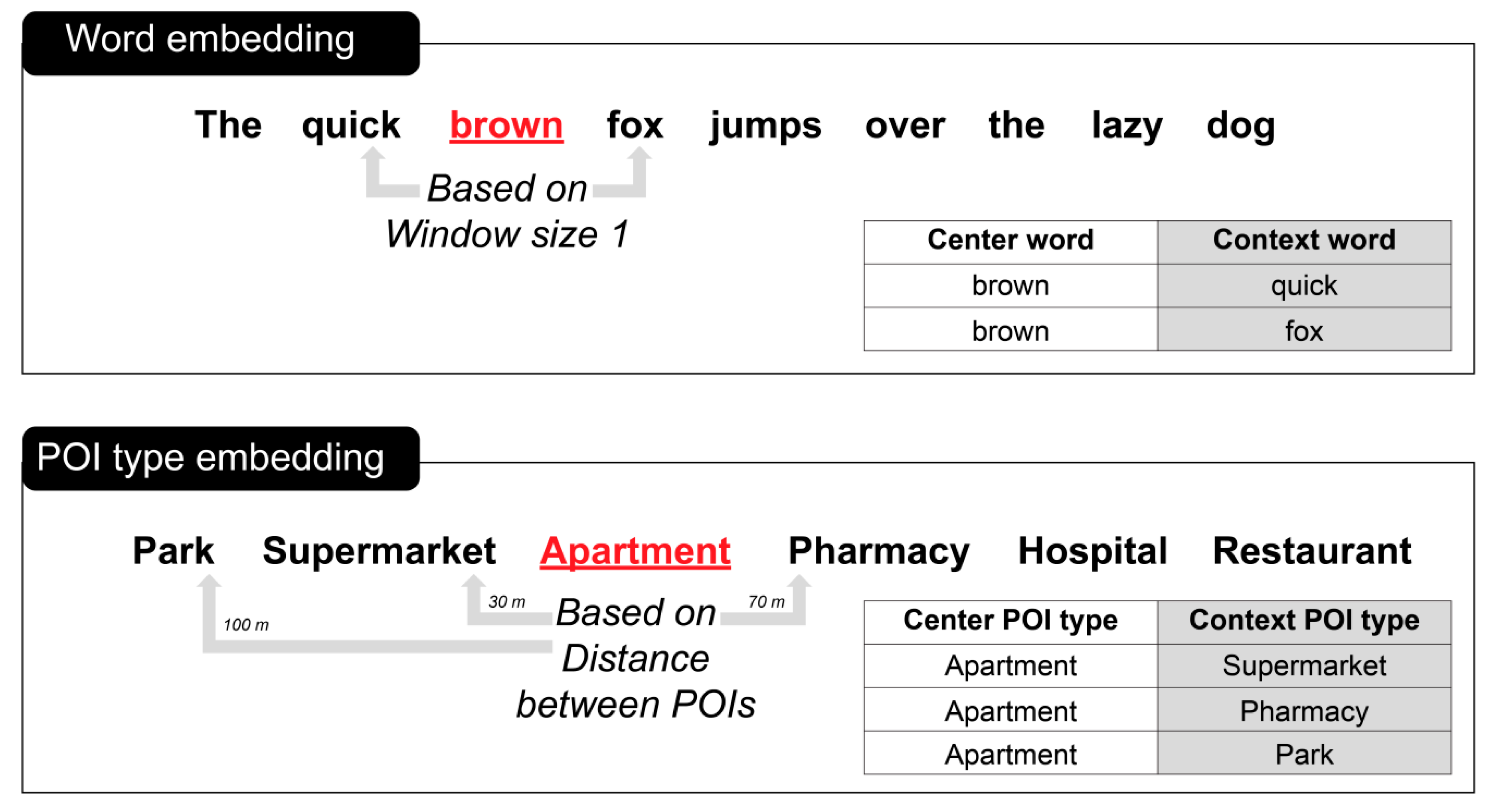
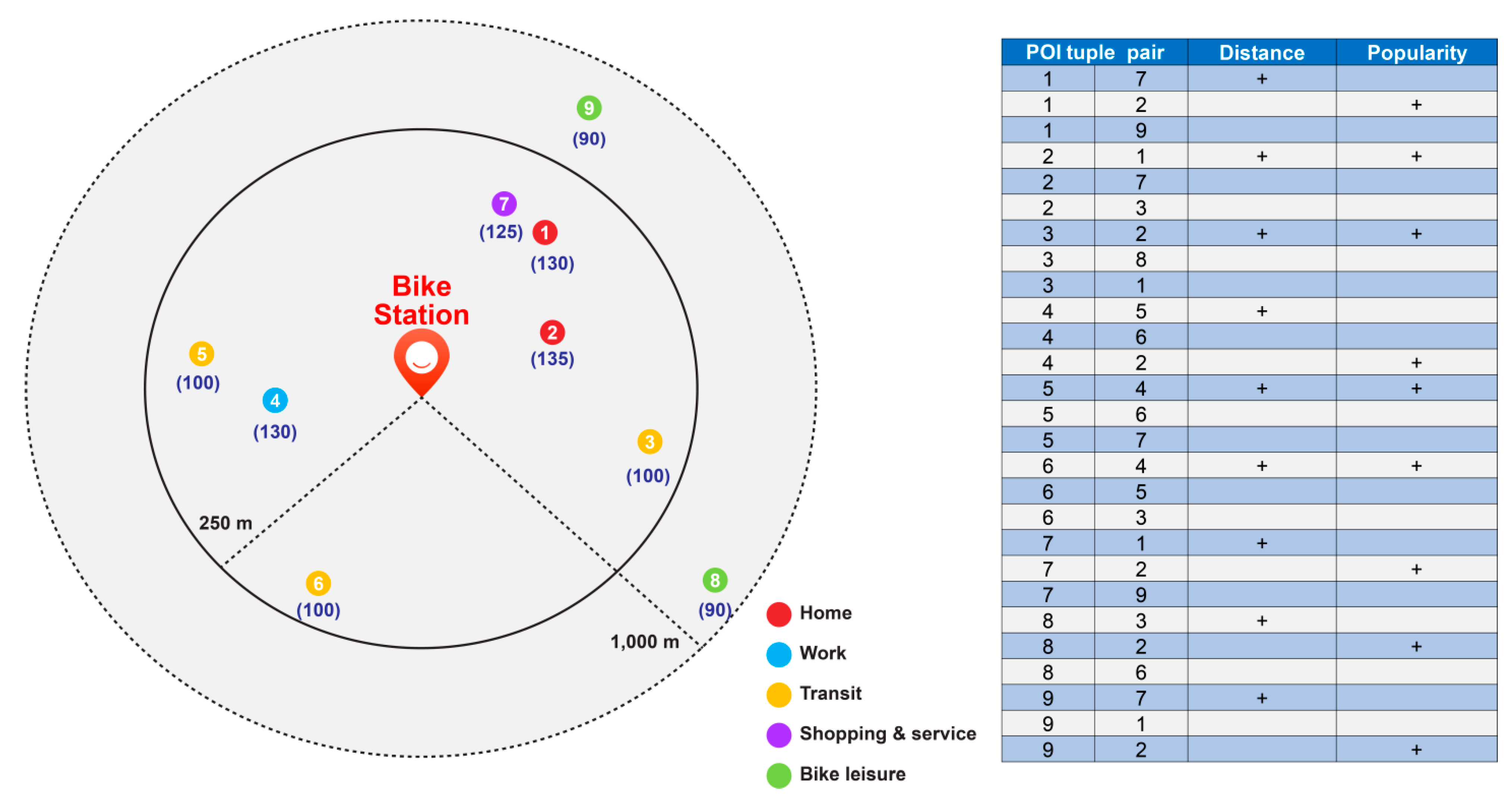
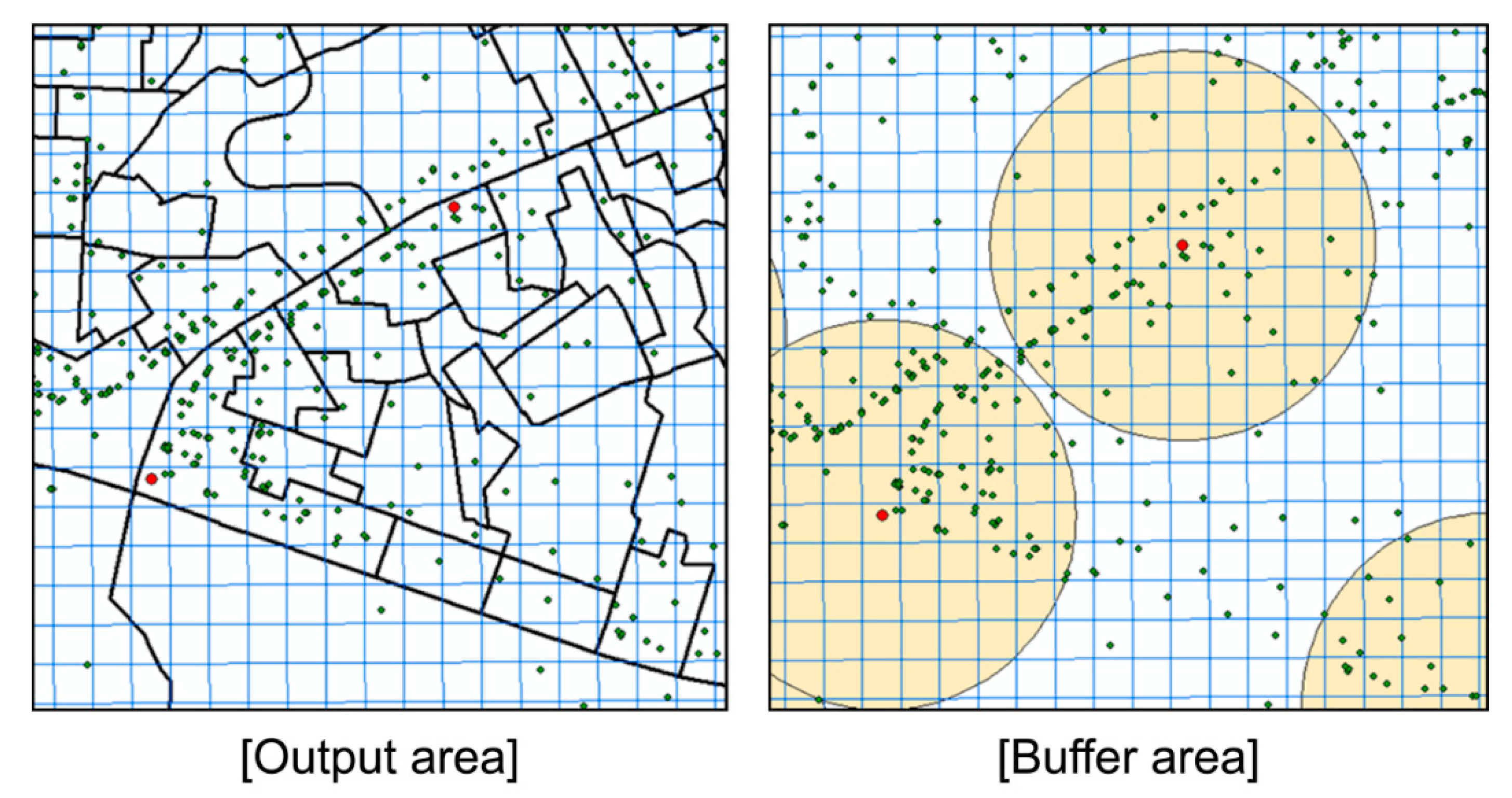
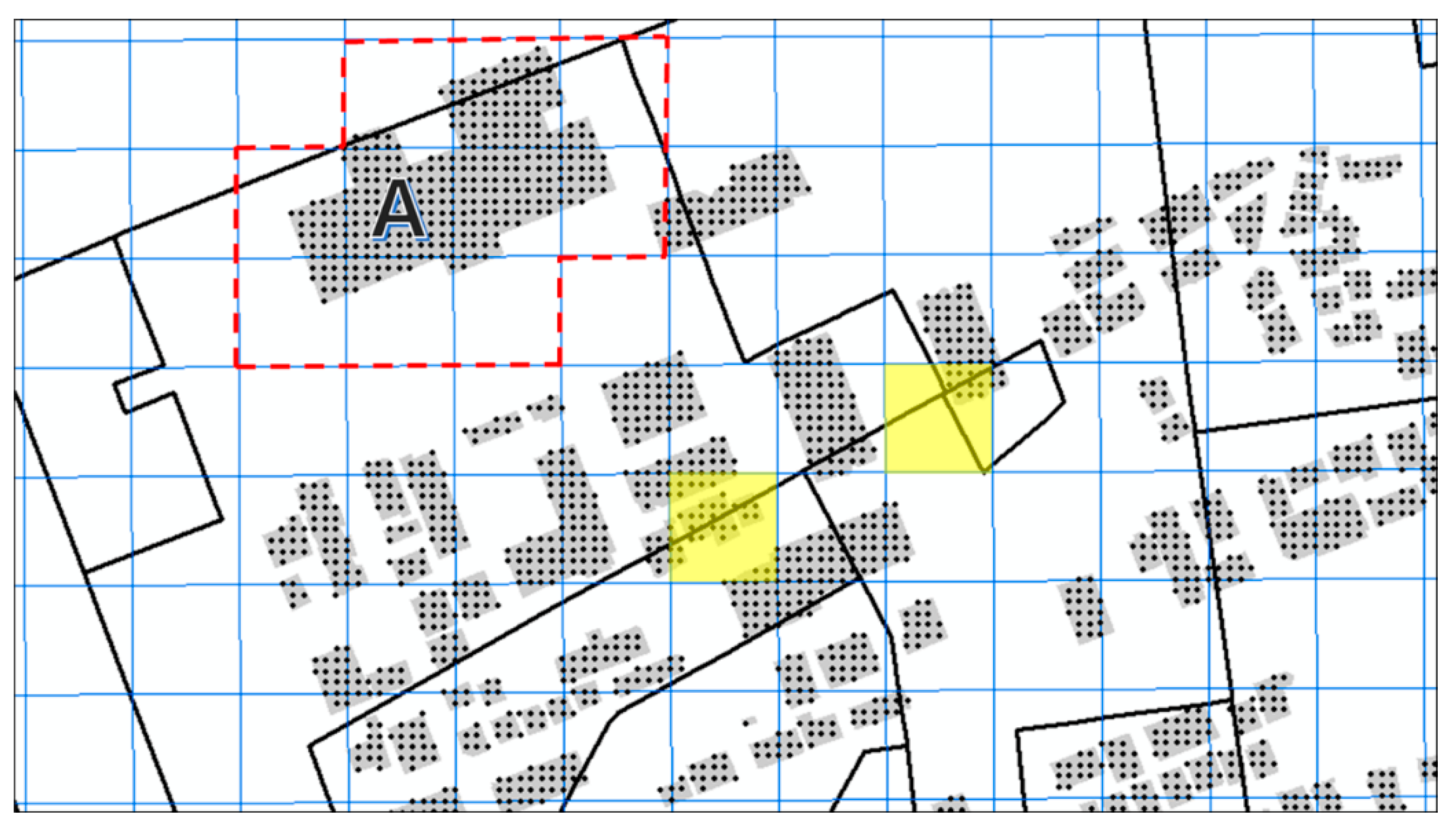

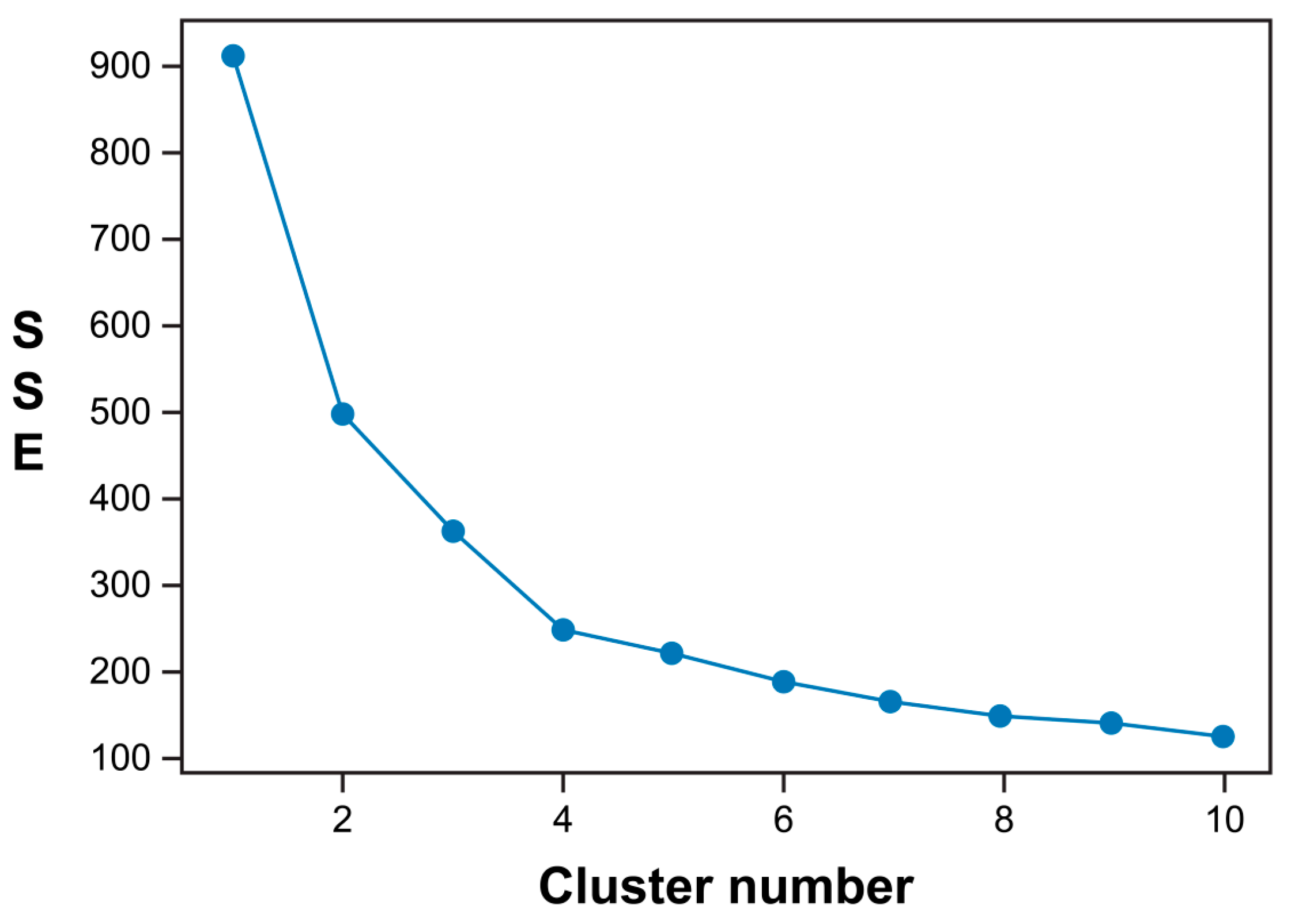
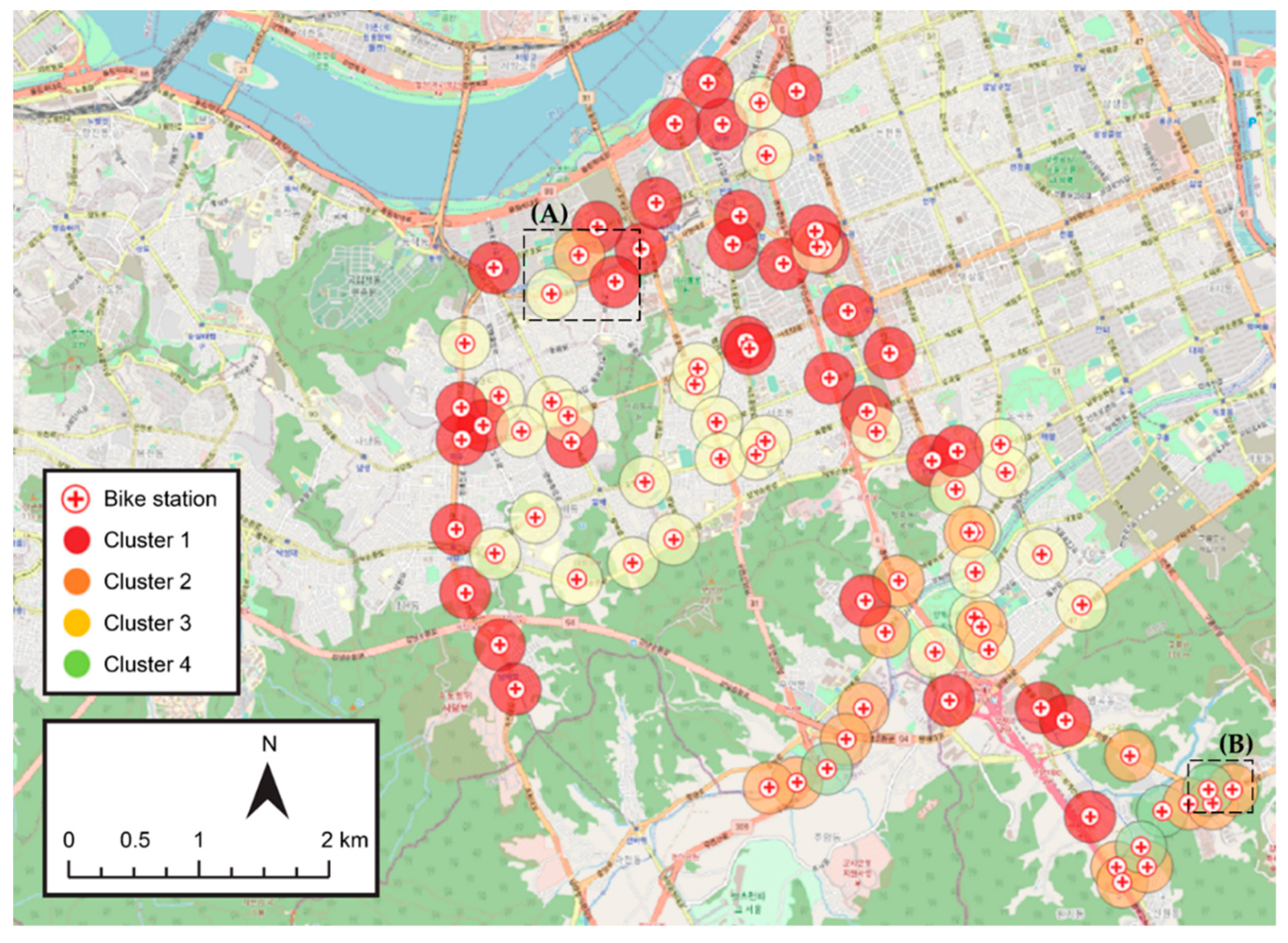
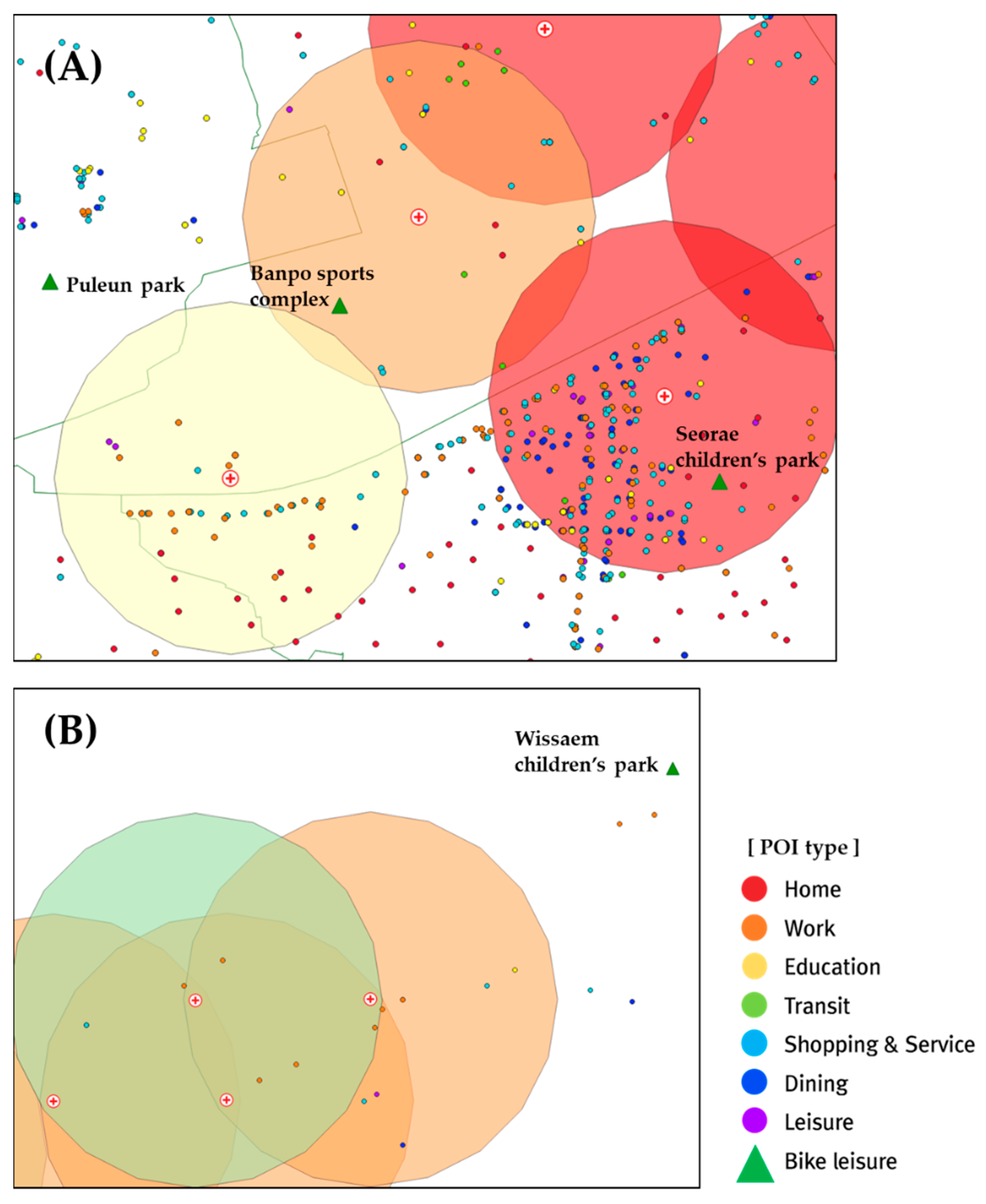
| Author | Object (Transportation Mode) | Data | Method | Accuracy(%) | Ground Truth | Research Domain 5 |
|---|---|---|---|---|---|---|
| Ermagun et al. [14] | People | TBI 1 survey, POI data | Random forest | 64.17 | TBI survey | |
| Meng et al. [29] | People | CHTS 2 survey, POI data, Social media (Twitter) | Dynamic Bayesian network | 87.8 | CHTS survey | TS 6 |
| Bao et al. [1] | Bikes | Smart card data, POI data | k-means, LDA | - | - | |
| Cui et al. [13] | People | CHTS survey, POI data, Social media (Twitter) | Bayesian neural network | 90.52 | CHTS survey | TS |
| Alsger et al. [17] | Public transports (subways, buses) | HTS 3 survey, OD 4 survey, Smart card data, land use data, etc. | Rule-based methods | 78 | HTS survey | |
| Chen et al. [34] | Taxis | Taxi GPS data, POI data | Auto encoder, k-means | - | - | HG 7 |
| Xing et al. [2] | Bikes | Mobike data, POI data | k-means++ | - | - |
| Author | Data | Number of POI Types | Method of Spatial Context Augmentation | Embedding Method | Embedding Dimension |
|---|---|---|---|---|---|
| Yan et al. [24] | Yelp POI data | 22 | ITDL 1 | Skip-gram | 70 |
| Yao et al. [27] | Baidu Maps POI data | 419 | Distance | CBOW 2 | 200 |
| Zhai et al. [25] | Baidu Maps POI data | 22 | Distance | Skip-gram | 70 |
| Liu et al. [39] | Yelp POI data | 842 | Distance | Skip-gram | - |
| Jin et al. [40] | YIWUGOU Shop data | - | Shop and product | Skip-gram | - |
| Liu et al. [23] | Gaode Maps POI data | 488 | Distance | Skip-gram | 100 |
| Author | Object (Transportation Mode) | Trip Purpose Classes | Number of Classes |
|---|---|---|---|
| Ermagun et al. [14] | People | Education, shopping, social recreation and community, eating out, personal business | 5 |
| Meng et al. [29] | People | Education, shopping, eating out, recreation, personal, transportation | 6 |
| Bao et al. [1] | Bike | Home, eating, leisure, shopping, transport, education | 6 |
| Alsger et al. [17] | Public transport | Work, education, shopping, recreation, home | 5 |
| Chen et al. [34] | Taxi | Dining, recreation, work, homing, others | 5 |
| Zhao et al. [10] | Bike | (Land use) residence, work, consumption, transit | 4 |
| This study | Bike | Home, work, education, transit, dining, shopping and service, leisure, bike leisure | 8 |
| Actual Class | |||
|---|---|---|---|
| 0 | 1 | ||
| Predicted class | 0 | True negative (TN) | False negative (FN) |
| 1 | False positive (FP) | True positive (TP) | |
| Bike Trip Purpose | POI Type | Location Radius |
|---|---|---|
| Home | Apartment, row house | 250 m |
| Work | Police station, industrial complex corporation, financial institution, company, embassy, town office, broadcasting station, court prosecutor’s office, foreign mission | 250 m |
| Education | University, library, cultural center, museum, school, academy, kindergarten | 250 m |
| Transit | Airport, bus stop, parking lot, subway station, railway station, taxi stop, terminal | 250 m |
| Shopping and service | Other facility, facility in the complex, large shopping mall, shopping center, bookstore, repair shop, gas station | 250 m |
| Dining | Restaurant, cafe | 250 m |
| Leisure | Stadium, golf course, church, fishing ground, cemetery, cultural property, mountain, lodging facility, movie theater, wedding hall, hot spring, temple, river, port, beach, rest area | 250 m |
| Bike leisure | Parks, amusement parks, leisure sports | 1000 m |
| POI Type | Embedding Values (70 Dimensions) |
|---|---|
| Home | 1.4437118, −0.49141836, 0.37585074, 1.2514722, ……, −0.008957267, 0.43792307 |
| Work | −0.4497794, 1.2613311, −1.0206449, −0.18877816, ………, 2.1714773, 1.7034453 |
| Education | 2.1038136, −1.1537447, 1.9189929, −0.13579279, …………, −1.3273395, 1.3194451 |
| Transit | 0.7793237, 1.3215489, 1.6597316, 1.5443871, …………, 0.22104016, −0.8933525 |
| Shopping and service | 1.4498143, 1.2004231, 0.3364074, −0.8220532, …………, −0.13508117, 0.29791373 |
| Dining | 0.75449663, 0.02276361, −1.2446628, −2.0252762, ………, 1.1871392, −0.5045676 |
| Leisure | −0.22978044, 1.8953556, 0.82838845, −0.100471795, ……, 1.3570645, −1.5268697 |
| Bike leisure | 1.2568898, −0.005698264, 0.6222984, 0.88474447, ……, −1.7393752, −0.40834773 |
| Division | Feature Name | Data Representation |
|---|---|---|
| Feature 1 | Riding day | 1 (workday), 0 (non-workday) |
| Feature 2 | Time zone of origin | 0, 1, 2, 3, ……, 23 |
| Feature 3 | Land use at origin | 1, 2, 3, 4 |
| Feature 4 | Time zone of destination | 0, 1, 2, 3, ……, 23 |
| Feature 5 | Land use at destination | 1, 2, 3, 4 |
| Feature 6 | Trip time between origin and destination | (ex) 2 h |
| Feature 7 | Trip distance between origin and destination | (ex) 20,000 m |
| Feature 8 | POI distance between origin and destination | (ex) 0 m |
| Actual Class | |||||||||
|---|---|---|---|---|---|---|---|---|---|
| Target | H | W | E | T | S | D | L | BL | Total |
| Home | 3016 | 286 | 14 | 100 | 722 | 54 | 214 | 42 | 4448 |
| Work | 240 | 7008 | 36 | 224 | 968 | 232 | 8 | 20 | 8736 |
| Education | 24 | 36 | 284 | 14 | 276 | 30 | 16 | - | 680 |
| Transit | 82 | 276 | 14 | 1686 | 248 | 20 | 2 | 26 | 2354 |
| Shopping and service | 634 | 1004 | 238 | 178 | 21,182 | 892 | 342 | 86 | 24,556 |
| Dining | 70 | 282 | 54 | 24 | 1042 | 2250 | 20 | - | 3742 |
| Leisure | 154 | 6 | 2 | - | 272 | 32 | 794 | - | 1260 |
| Bike Leisure | 68 | 22 | - | 12 | 64 | - | - | 240 | 406 |
| Total | 4288 | 8920 | 642 | 2238 | 24,774 | 3510 | 1396 | 414 | 46,182 |
Publisher’s Note: MDPI stays neutral with regard to jurisdictional claims in published maps and institutional affiliations. |
© 2021 by the authors. Licensee MDPI, Basel, Switzerland. This article is an open access article distributed under the terms and conditions of the Creative Commons Attribution (CC BY) license (https://creativecommons.org/licenses/by/4.0/).
Share and Cite
Lee, J.; Yu, K.; Kim, J. Public Bike Trip Purpose Inference Using Point-of-Interest Data. ISPRS Int. J. Geo-Inf. 2021, 10, 352. https://0-doi-org.brum.beds.ac.uk/10.3390/ijgi10050352
Lee J, Yu K, Kim J. Public Bike Trip Purpose Inference Using Point-of-Interest Data. ISPRS International Journal of Geo-Information. 2021; 10(5):352. https://0-doi-org.brum.beds.ac.uk/10.3390/ijgi10050352
Chicago/Turabian StyleLee, Jiwon, Kiyun Yu, and Jiyoung Kim. 2021. "Public Bike Trip Purpose Inference Using Point-of-Interest Data" ISPRS International Journal of Geo-Information 10, no. 5: 352. https://0-doi-org.brum.beds.ac.uk/10.3390/ijgi10050352






